|
Réponse |
Message 1 de 79 de ce thème |
|
  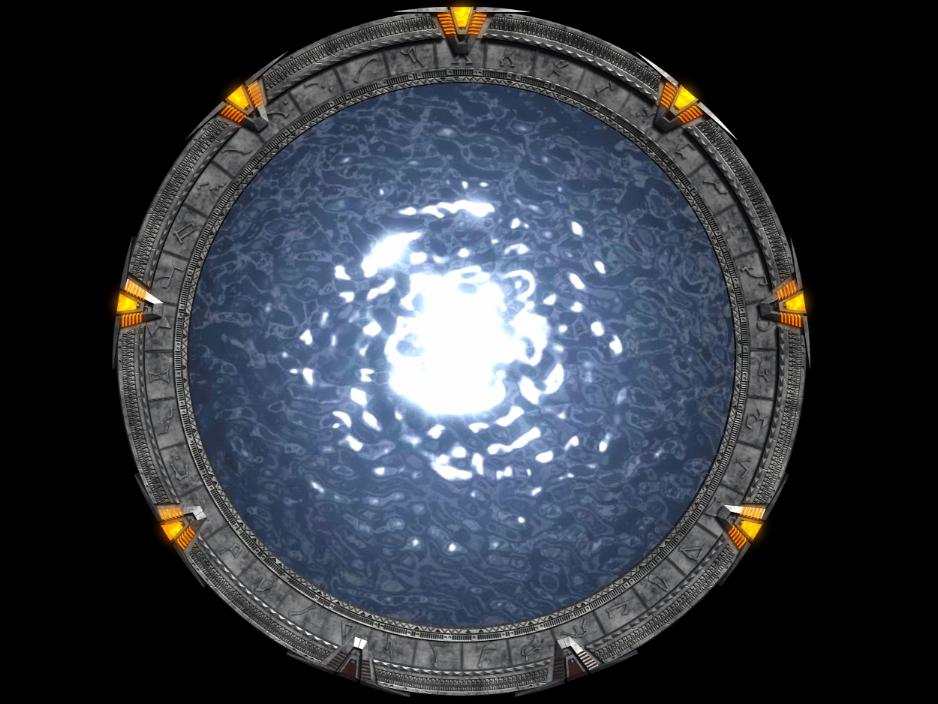
Sabemos que la verdadera luna nueva es en luna llena como hemos estudiado en otro panel.
El verdadero reposo sabatico es segun las fases de la luna.
La sabiduria/sabado/sophia tiene fuerte connotacion con el sol y la luna.
¿El dia comienza a la PUESTA O A LA SALIDA DEL SOL?
Aparte tambien hemos visto en otro panel que el piso de la luna llena, para determinar el año nuevo hebreo, es el 22 de febrero, para que nos caiga el verdadero PENTECOSTES, el 20 de junio en solsticio. Osea que siempre que tengamos luna llena entre el 22 de febrero, inclusive hasta el 23 de marzo, tambien incluido, es el primer dia del primer mes hebreo.
VERDADERO SHAVUOT
SHAVUOT JUSTO EL 20 DE JUNIO (SOLSTICIO) EN EL AÑO 1997. APARENTEMENTE EL 22 DE FEBRERO ES EL PISO PARA EL VERDADERO ROSH HASHANAH (AÑO NUEVO) HEBREO. TAMBIEN SE CUMPLIO DE ESA FORMA EN LOS AÑOS 1978, 1959, 1940 Y SERA ASI EN EL 2016, OSEA EN EL AÑO DEL BICENTENARIO DE LA INDEPENDENCIA ARGENTINA.
Génesis 8
1.
Y se acordó Dios de Noé, y de todos los animales, y de todas las bestias que estaban con él en el arca; e hizo pasar Dios un viento sobre la tierra, y disminuyeron las aguas.
2. Y se cerraron las fuentes del abismo y las cataratas de los cielos; y la lluvia de los cielos fue detenida.
3. Y las aguas decrecían gradualmente de sobre la tierra; y se retiraron las aguas al cabo de ciento cincuenta días.
4. Y reposó el arca en el mes séptimo, a los diecisiete días del mes, sobre los montes de Ararat.
5. Y las aguas fueron decreciendo hasta el mes décimo; en el décimo, al primero del mes, se descubrieron las cimas de los montes. (La luna llena que marca el primero del decimo mes es EL OCTAVO DIA DE LA FESTIVIDAD DE JANUKAH. TENGAMOS EN CUENTA en este contexto que EL SEPTIMO DIA DE JANUKAH ES SHABBAT LUNAR, osea el mismo 30 de KISLEV. El primero de JANUKAH es el 24 de KISLEV SEGUN EL LIBRO DE AGEO EN SU CAPITULO 2. Tengamos en cuenta que el SEPTIMO DIA DE JANUKAH ES EL DIA NUMERO 266=2*133 DEL CALENDARIO HEBREO E INCLUSO EL OCTAVO DIA ES EL DIA NUMERO 267 DEL MISMO.)
6. Sucedió que al cabo de cuarenta días abrió Noé la ventana del arca que había hecho, (11 DE SHEVAT, OSEA 11/11, dia numero 306=2*153 del calendario LUNI-SOLAR HEBREO/GENESIS 30:6)
7. y envió un cuervo, el cual salió, y estuvo yendo y volviendo hasta que las aguas se secaron sobre la tierra.
8. Envió también de sí una paloma, para ver si las aguas se habían retirado de sobre la faz de la tierra.
DIA NUMERO 119
ROSH HASHANAH =RH = 1/1 = 1 /NISSAN (EXODO 12:1,2-EZEQUIEL 45:18)
LEVADURAS =LEV=15/1 = 15/NISSAN (LEVITICO 23:6)
DILUVIO UNIVER. =DIL =17/2 = 17/ISHAR (GENESIS 7:11)
OCHO DE SIVAN =SIV = 8/3 = 8/SIVAN
SHAVUOT =SHA=1 /5 = 1 /AV (APROXIMADO) (ESDRAS 7:8,9)
13 DE ELUL =ELU=13/6 = 13/ELUL
TROMPETAS =TRO=1 /7 = 1 /TISHRI (LEVITICO 23:24)
YOM KIPUR =YK =10/7 = 9-10/TISHRI (COMIENZA EN EL 9 DE TISHRI-LEVITICO 23:32)
TABERNACULOS =TAB= 15/7 = 15/TISHRI (LEVITICO 23:33)
SIMCHAT TORAH =STO=22/7 = 22/TISHRI (OCTAVO DIA) (LEVITICO 23:39)
JANUKAH =JAN =24/9 = 24/KISLEV (AGEO 2:18,20)
JANUKAH(8VO DIA)=TEV= 1/10= 1/TEVET (GENESIS 8:5/CALENDARIO DE NOE)
11/11 (DIA N-306) =SHE=11/11= 11/SHEVAT (GENESIS 8:6/CALENDARIO DE NOE)
PURIM =PUR=15/12=14-15/ADAR (ESTHER 9:15,21)
Años lunares en funcion al calendario gregoriano
RH LEV DIL SIV SHA ELU TRO YOM KIP TAB STO JAN TEV 11/11 PUR VEADAR
22/2 8/3 9/4 29/4 20/6 1/8 18/8 26-27/8 1/9 8/9 8/11 15/11 24/12 24-25/1 SI-11/2
23/2 9/3 10/4 30/4 21/6 2/8 19/8 27-28/8 2/9 9/9 9/11 16/11 25/12 25-26/1 SI-12/2
24/2 10/3 11/4 1/5 22/6 3/8 20/8 28-29/8 3/9 10/9 10/11 17/11 26/12 26-27/1 SI-13/2
25/2 11/3 12/4 2/5 23/6 4/8 21/8 29-30/8 4/9 11/9 11/11 18/11 27/12 27-28/1 SI-14/2
26/2 12/3 13/4 3/5 24/6 5/8 22/8 30-31/8 5/9 12/9 12/11 19/11 28/12 28-29/1 SI-15/2
27/2 13/3 14/4 4/5 25/6 6/8 23/8 31- 1/9 6/9 13/9 13/11 20/11 29/12 29-30/1 SI-16/2
28/2 14/3 15/4 5/5 26/6 7/8 24/8 1-2/9 7/9 14/9 14/11 21/11 30/12 30-31/1 SI-17/2
1/3 15/3 16/4 6/5 27/6 8/8 25/8 2-3/9 8/9 15/9 15/11 22/11 31/12 31/1-1/2 SI-18/2
2/3 16/3 17/4 7/5 28/6 9/8 26/8 3-4/9 9/9 16/9 16/11 23/11 1/1 1-2/2 SI-19/2
3/3 17/3 18/4 8/5 29/6 10/8 27/8 4-5/9 10/9 17/9 17/11 24/11 2/1 2-3/2 SI-20/2
4/3 18/3 19/4 9/5 30/6 11/8 28/8 5-6/9 11/9 18/9 18/11 25/11 3/1 3-4/2 SI-21/2
5/3 19/3 20/4 10/5 1/7 12/8 29/8 6-7/9 12/9 19/9 19/11 26/11 4/1 4-5/2 NO
6/3 20/3 21/4 11/5 2/7 13/8 30/8 7-8/9 13/9 20/9 20/11 27/11 5/1 5-6/2 NO
7/3 21/3 22/4 12/5 3/7 14/8 31/8 8-9/9 14/9 21/9 21/11 28/11 6/1 6-7/2 NO
8/3 22/3 23/4 13/5 4/7 15/8 1/9 9-10/9 15/9 22/9 22/11 29/11 7/1 7-8/2 NO
9/3 23/3 24/4 14/5 5/7 16/8 2/9 10-11/9 16/9 23/9 23/11 30/11 8/1 8-9/2 NO
10/3 24/3 25/4 15/5 6/7 17/8 3/9 11-12/9 17/9 24/9 24/11 1/12 9/1 9-10/2 NO
11/3 25/3 26/4 16/5 7/7 18/8 4/9 12-13/9 18/9 25/9 25/11 2/12 10/1 10-11/2 NO
12/3 26/3 27/4 17/5 8/7 19/8 5/9 13-14/9 19/9 26/9 26/11 3/12 11/1 11-12/2 NO
13/3 27/3 28/4 18/5 9/7 20/8 6/9 14-15/9 20/9 27/9 27/11 4/12 12/1 12-13/2 NO
14/3 28/3 29/4 19/5 10/7 21/8 7/9 15-16/9 21/9 28/9 28/11 5/12 13/1 13-14/2 NO
15/3 29/3 30/4 20/5 11/7 22/8 8/9 16-17/9 22/9 29/9 29/11 6/12 14/1 14-15/2 NO
16/3 30/3 1/5 21/5 12/7 23/8 9/9 17-18/9 23/9 30/9 30/11 7/12 15/1 15-16/2 NO
17/3 31/3 2/5 22/5 13/7 24/8 10/9 18-19/9 24/9 1/10 1/12 8/12 16/1 16-17/2 NO
18/3 1/4 3/5 23/5 14/7 25/8 11/9 19-20/9 25/9 2/10 2/12 9/12 17/1 17-18/2 NO
19/3 2/4 4/5 24/5 15/7 26/8 12/9 20-21/9 26/9 3/10 3/12 10/12 18/1 18-19/2 NO
20/3 3/4 5/5 25/5 16/7 27/8 13/9 21-22/9 27/9 4/10 4/12 11/12 19/1 19-20/2 NO
21/3 4/4 6/5 26/5 17/7 28/8 14/9 22-23/9 28/9 5/10 5/12 12/12 20/1 20-21/2 NO
22/3 5/4 7/5 27/5 18/7 29/8 15/9 23-24/9 29/9 6/10 6/12 13/12 21/1 21-22/2 NO
23/3 6/4 8/5 28/5 19/7 30/8 16/9 24-25/9 30/9 7/10 7/12 14/12 22/1 22-23/2 NO
ROSH HASHANAH =2/3
LEVADURAS=16/3
DILUVIO UNIVERSAL=17/4
8 DE SIVAN=7/5
SHAVUOT=28/6
TROMPETAS=26/8
YOM KIPUR=3-4/9
TABERNACULOS=9/9
SIMCHAT TORAH=16/9
JANUKAH=16/11
JANUKAH (8VO DIA)=23/11 (GENESIS 8:6)
11/11 (HEBREO)=1/1 (MISTERIO-AÑO NUEVO DEL AÑO 2000 EQUIVALE AL 11/11 DEL ARCA DE NOE)
PURIM=1-2/2
SECUENCIA LUNAR DE 1999-2000
|
|
|
|
Réponse |
Message 35 de 79 de ce thème |
|
Jano
De Wikipedia, la enciclopedia libre
Jano (en latín Janus, Ianus) es, en la mitología romana, un dios que tenía dos caras mirando hacia ambos lados de su perfil, padre de Fontus. Jano era el dios de las puertas, los comienzos y los finales. Por eso le fue consagrado el primer mes del año (que en español pasó del latín Ianuarius a Janeiro y Janero y de ahí derivó a enero). Como dios de los comienzos, se le invocaba públicamente el primer día de enero (Ianuarius), el mes que derivó de su nombre porque inicia el nuevo año. Se le invocaba también al comenzar una guerra, y mientras ésta durara, las puertas de su templo permanecían siempre abiertas; cuando Roma estaba en paz, las puertas se cerraban. Jano no tiene equivalente en la mitología griega.
Al igual que Prometeo, Jano es una clase de héroe cultural, ya que se le atribuye entre otras cosas la invención del dinero, las leyes y la agricultura. Según los romanos, este dios aseguraba buenos finales.
Dentro de los muchos apelativos que recibe el dios, vale la pena destacar dos: Jano Patulsio (patulsius), que era usado para invocar la cara del dios que se ubicaba delante de la puerta por quien deseaba atravesarla (para entrar o salir). Como complemento, la cara que se le opone a ésta del otro lado de la puerta, es invocada como Jano Clusivio (clusivius). Ambos nombres declaran la doble funcionalidad del dios.[cita requerida]
Jano es citado en la novela de Albert Camus, La caída, donde simboliza la dualidad del personaje entre el pasado y el futuro.
El Dios Jano también es citado en el poema "La mujer de Jano", del libro de poesía Ama/zonas, del poeta uruguayo Paulo Roddel, publicado en 2014.
En su tratado sobre los Fastos, Ovidio caracteriza a Jano como aquel que él solo custodia el Universo.
http://es.wikipedia.org/wiki/Jano
|
|
|
|
Réponse |
Message 36 de 79 de ce thème |
|
|
|
|
Réponse |
Message 37 de 79 de ce thème |
|
|
|
|
JANUS
CON
LA LLAVE
Y EL GALLO
Por
Luis Bernardo
Palacio Acosta
Bodhisattwa del
V.M. THOTH-MOISÉS
|
|
JANUS CON LA LLAVE
Y EL GALLO
El Primer Día del Año, es decir, el Día Primero de Enero de cada Año es dedicado al Dios Jano, Janus, Cronos o Saturno, Iao, Baco, Iod-Hevé, Thoth, Hermes y Mercurio.
"Dupuis fue el primer erudito que identificó a San Pedro como Janus [el término janitor, originalmente el que tiene las llaves, deriva de Janus]. Janus alternadamente deriva de Dianus (Día), un Dios de las horas de la luz del día, la forma masculina de Diana la Deidad “Lunar” [Venusta, mejor dicho]. Janus es considerado el Dios de las Puertas, especialmente responsable [como San Pedro] del Portal del Cielo. El mes de Enero es llamado así en honor de Janus. (...). En los antiguos días Janus estaba en el cielo medio en la salida del Sol alrededor del Solsticio de Invierno, abriendo así un Año Nuevo. Janus es no solamente competente para abrir y cerrar días y años, sino también guerra y paz. (...) Así como Janus conduce el círculo anual de los signos zodiacales, San Pedro conduce a los Doce Apóstoles del Cristianismo Romano. Hércules es llamado un Portador de la Maza, pero Llave y Maza pueden ser expresados como sinónimos en Latín: Hércules es por lo tanto, un portador de las Llaves igual que Janus."
"Las regiones del Cercano Oriente tienen la mayoría de la lluvia en invierno. Esto conduce al cuadro de Janus como Barquero a través de la inundación del invierno. (...) Janus como Barquero se refiere otra vez a la actividad de Pedro como pescador. Janus fue representado no solamente con la Llave del Cielo, sino también con una Vara Larga que puede ser reinterpretado como la Vara del pastor con la que San Pedro mira a las Ovejas (...)"
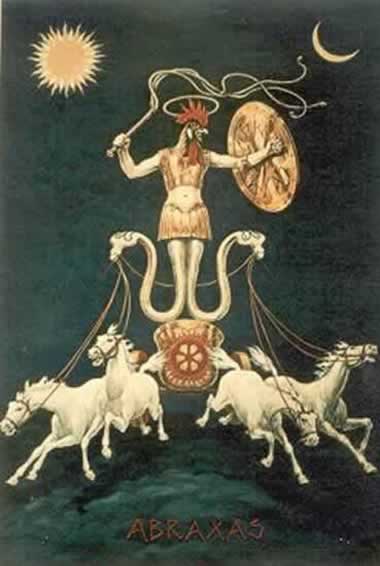
- Abraxas -
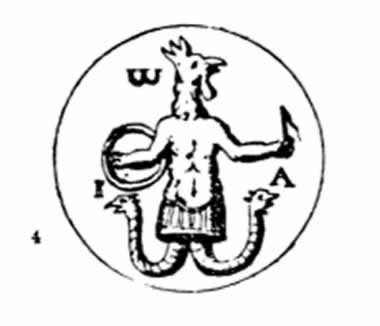
Antigua Gema Gnóstica con la figura del Abraxas y el Nombre Inefable de Dios IAW (IAO), el Anubis y Hermes-Cristo de los Gnósticos.
En la obra "The Gnostics and Their Remains", en el capítulo titulado "The Abraxas", su autor "Charles William King", [1887], en referencias al Dios ANUBIS, lo describe
"... portando el caduceo de Hermes para denotar su oficio de conductor de almas [psicopompo], no… a través de las sombras del submundo, sino a lo largo del sendero planetario hasta su final reposo en el Pleroma. Así el Evangelio Gnóstico "Pistis Sophía", describiendo al Salvador [Jesús Cristo] después de haber recibido su Vestidura de Luz, con las cinco palabras de poder inscritas y con los nombres de todas las Dominaciones encontradas en su Ascensión, lo hace venir primero a la Puerta del Firmamento, luego al Dios de la esfera, luego a la esfera del Destino, y finalmente a los Doce grandes Aeones: cuyos Poderes todos cuando vieron sus propios nombres escritos en su vestidura quedaron impresionados con temor y comenzaron a cantar himnos a Él."
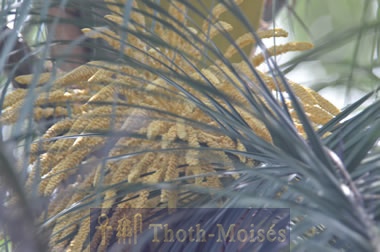
"Este ANUBIS-HERMES aparece algunas veces ondeando una rama de palma, para proclamar su victoria sobre los Poderes del Mal; o presidiendo a la psychostasia "peso de las almas", la escena comúnmente pintada en el Ritual Egipcio de la Muerte. En el último carácter, él aparece aquí como Cristo, el Juez;… En las antiguas Gemas griegas Hermes es a menudo representado inclinándose hacia adelante, con el caduceo en la mano, y por su mística virtud asistiendo a un alma emergiendo de la profundidad de la tierra -- una extraña coincidencia en forma, probablemente también en origen, con la medieval pintura del Salvador [Jesús el Cristo] sacando almas del Purgatorio…" […]
"Hermes en este particular carácter de Psychopompos, fue muy utilizado por los Naasenos (Ofitas) como el profético representante del Salvador en su grandioso oficio. Ellos interpretaron a Hermes conduciendo a las almas a través de la oscuridad dentro del Elysium así como Cristo guía las mentes de los iluminados, fuera de la ignorancia, dentro del Conocimiento [Gnosis], en todo su especial sentido de las palabras…"
Un poco más adelante, este mismo autor, dice:
"Este doble carácter de ANUBIS es... expresado… [como] el Buen Pastor, cargando un cordero sobre sus hombros, recostado sobre su cayado, sus lomos atados con un cinto [o ceñidor]… Pero un examen más detenido … se resuelve en el Dios de dos cabezas de Egipto… el "ladrador Anubis"… " ("The Gnostics and Their Remains".)
El "ladrador Anubis", en dos palabras: ¡El Veltro!
"... el gallo, heraldo del Sol, estaba consagrado al Dios Mercurio..." (Fulcanelli, “Las Moradas Filosofales”).
El Gallo (GAIO, o I.A.O.) es el atributo del Apóstol Pedro. Cuando el Gallo de la Alquimia, de la Pasión, Canta por tercera vez, es el anuncio de la Resurrección.
"El Gallo" es el emblema de la Resurrección. Simboliza también al Mercurio de la Alquimia, las Energías Creadoras Sexuales, que el Alquimista Transmuta por medio de "La Llave" que es el Arte y la Ciencia de la Transmutación Sexual, tal y como está en las Obras de nuestro Venerable y Amado Maestro Samael Aun Weor, de nuestro Venerable y Amado Maestro Rabolú y del V.M. Thoth-Moisés. (Ver nuestro Trabajo titulado "Preparación para ser un Fiel Discípulo de la Logia Blanca").
El Divino Jerarca de la Ley de Dios Anubis es asimismo Hermes y Thoth:
"... 'Hermanubis (Egipcio).- O sea: Hermes-Anubis, 'el revelador de los misterios del mundo inferior' -no del infierno o Hades, como se ha interpretado erróneamente, sino de nuestra Tierra (el mundo más inferior de la cadena septenaria de mundos) -y también de los misterios sexuales. Kreuzer debe haber adivinado la verdadera interpretación, por cuanto denomina a Anubis-Thoth-Hermes 'un símbolo de la ciencia y del mundo intelectual'... ".
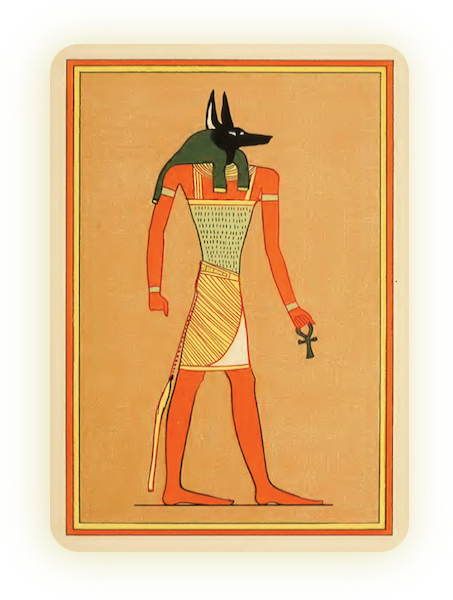
"Estaba siempre representado teniendo en la mano una cruz,..." (G.T. H.P.B.), el "Ankh", la Cruz de Thoth.
|
|
|
|
Réponse |
Message 38 de 79 de ce thème |
|
"PEDRO"
"EL MOISÉS DE LA NUEVA ALIANZA" "MOISÉS EL PROTOTIPO DE PEDRO"
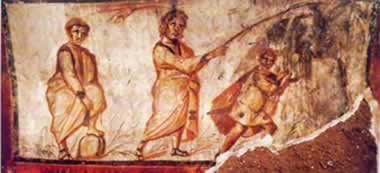
Moisés-Pedro representados en las Catacumbas de San Calixto en Roma, “en la pared derecha del arcosolio...”
En "Las Catacumbas Cristianas de San Calixto en Roma", en "la Zona de San Cayo y de San Eusebio", y en "El Cubículo de las Ovejitas", se puede apreciar en el fondo un sepulcro, compuesto de un nicho para sarcófago con un arco encima... "En el centro del arcosolio está la imagen del Buen Pastor con la ovejita sobre sus hombros, rodeado del rebaño (un carnero y unas ovejas)."
"La escena representa la imagen del Buen Pastor que lleva al difunto entre las filas de los bienaventurados. (...)" [1*]
"En la pared derecha del arcosolio está representado Moisés que se desata las sandalias. Junto a él aparece Pedro en el acto de golpear la roca para hacer manar agua. Un soldado con la espada ceñida, se acerca a la fuente y toma el agua con las dos manos. Moisés es símbolo de la antigua Ley, Pedro de la nueva. El agua de la roca es símbolo de la del bautismo; el soldado vestido como un militar romano representa a los primeros cristianos convertidos por Pedro."
"En sarcófagos de Catacumbas Romanas se ilustra en imágenes la "traditio legis" en que "Pedro", como "el Moisés de la Nueva Alianza", recibe de las manos de Cristo (Dominum legem dat), el Nuevo Testamento, la Lex o Ley que él fue a proclamar y explicar a los Cristianos."
También en "Pequeños objetos hallados en las catacumbas", se hallan diseños en algunos sarcófagos:
"Así el diseño de Moisés que golpea con fuerza la roca en el desierto y el agua que chorrea muestra la inscripción "Petrus", una prueba que los Cristianos primitivos vieron en el líder de los Israelitas (en Moisés) el prototipo de Pedro que en este caso se considera como el mediador durante las primaveras cristianas de gracia, y en los cuadros de la Transmisión de la Ley (Dominus legem dat), como el mediador de las verdades de salvación."
[1*] Es decir, como Psicopompo o Conductor de Almas, como es llamado asimismo el Dios Hermes-Anubis el Dios Psicopompo y Conductor de las Almas...
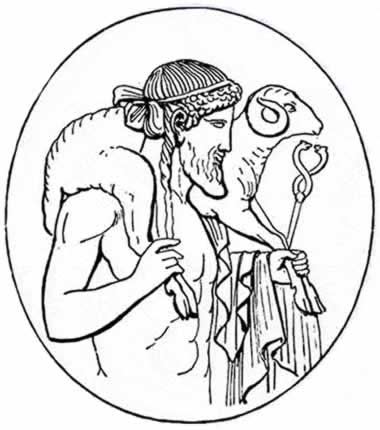
- Mercurio o Hermes como el Buen Pastor -
"Mercurio, (...) idéntico al MITHRA Mazdeísta, (...) el compañero perpetuo del Sol de la Sabiduría. (...) el Nuncio y el Lobo del sol (...) Mercurio es también 'HERMES-ANUBIS' el buen inspirador o AGATHODAEMON. Como Ave de Argos, vela sobre la Tierra,..." (Enseñanzas de nuestro Venerable y Amado Maestro Samael Aun Weor).
"... su nombre Hermes significa, entre otras cosas, el 'Intérprete': la Palabra, el LOGOS, o VERBO," ("La Doctrina Secreta", Volumen IV, Sección VIII).
“... PEDRO, PETRA O PIEDRA, era el propio Hierofante o el intérprete en Fenicio,...” (De la Gran Obra “Las Tres Montañas” de nuestro Venerable y Amado Maestro Samael Aun Weor).
"Petra o Kiffa puede equipararse, por un fácil juego de palabras, al de Petroma. El Petroma era un par de tablas de piedra, que usaban los hierofantes en el misterio final de las iniciaciones..."
"En los países orientales y especialmente entre los fenicios y caldeos, el nombre de Peter era el título de los intérpretes..."
"PTR es literalmente el antiguo 'Patar' hebreo y aramaico, que en la historia de José significa intérprete, por lo que también la palabra Pitrum se aplica a la interpretación de los textos y sueños." (“La Doctrina Secreta”, Volumen 5, H.P. Blavatsky).
“El apostólico nombre de Pedro deriva de los Misterios, cuyo hierofante llevaba el título caldeo de Peter (...), que significa intérprete...” (“Isis sin Velo”, Volumen III, H.P. Blavatsky).
"... Pator, o Petor, fue una palabra Egipcia; y Moisés hablando de José, y los sueños del Faraón, la utiliza más de una vez. Estas visiones fueron explicadas por Joseph (José); él interpretó los sueños de Faraón: por esta razón el título de Pator es reconocido por los Rabinos entre los nombres de Joseph (José). Allí se piensa que es la misma alusión a la interpretación divina en el nombre del apóstol Pedro..." (Jacob Bryant, "A New System; or, an Analysis of Ancient Mythology...").
"... Hay en la historia de cada templo oracular alguna leyenda acerca de una piedra; alguna referencia a la palabra Petra. Aclarando esto, es necesario observar, que cuando el culto del Sol casi era universal, éste incluso era un nombre de esa Deidad entre los griegos. Ellos lo llamaron Petor, y Petros; y su templo se llamó Petra. (...) Había sin embargo algunos escritores que lo mencionaron como el nombre del Sol y no eran totalmente ignorantes de su significado..."
"... el Sol es llamado Petra..."
"... el nombre del Sol, y de sus templos, estaba entre los antiguos Griegos Petros, y Petra; (...) ese Petros era un nombre del Sol. Era una palabra de origen egipcio, derivada de Petor, (...)" (Jacob Bryant, "A New System; or, an Analysis of Antient Mythology...").
El Iniciado Gnóstico Cristiano Clemente de Alejandría, en su Libro "Stromata", Volumen I, Capítulo XXIII, identifica al Profeta Moisés con el Apóstol Pedro, donde dice:
"154.1. Los iniciados dicen que [Moisés] mató al egipcio con solo (el poder de) su palabra, al igual que haría más tarde Pedro, como refieren los Hechos (Hechos 5.1-10), quien mata con su palabra a los que devolvieron una parte del precio del terreno con mentira.
2. Artapano (Artapano, Fragmentos 726 F 3 b) en su tratado sobre Los Judíos, relata que Moisés, hecho prisionero de Jenefres, rey de los egipcios, al reclamar la liberación de su pueblo respecto de Egipto, por la noche salió de prisión, abierta por voluntad de Dios, y, penetrando en el palacio, se presentó ante el rey, que dormía y le despierta; 3. éste, atemorizado por el suceso, manda a Moisés que le diga el nombre del Dios que le ha enviado, y Moisés se inclinó a su oído y se lo susurró; pero el rey, al oírlo, cayó muerto sin voz, mas ayudado por Moisés recobró la vida."
Un poco más adelante dice Clemente de Alejandría:
"... Ahora bien, el intérprete de las leyes [*] es aquel mismo a través del cual fue dada la ley [Juan 1. 17 (“Porque la ley por Moisés fué dada:...” )]; él es el primer intérprete de los mandamientos divinos,..." (Clemente de Alejandría “Stromata”, Volumen I).
Son evidentes las relaciones que establece Clemente de Alejandría entre el Profeta Moisés y el Apóstol Pedro.
[*] "PEDRO, discípulo de JESÚS el CRISTO, es el ALADINO, el intérprete maravilloso, autorizado para alzar la PIEDRA que cierra el Santuario de los grandes Misterios." (Así lo Enseña nuestro Venerable y Amado Maestro Samael Aun Weor.)
“... En los países orientales se designaba al hierofante con el título de... (Pedro), que en caldeo y fenicio significa intérprete. Hay en todo esto reminiscencias de la ley mosaica,...”
“... El apostólico nombre de Pedro deriva de los Misterios, cuyo hierofante llevaba el título caldeo de Peter, que significa intérprete...” ("Isis sin Velo", Volumen 3, H.P. Blavatsky.)
En los Textos Esenios de Qumrán, "el Intérprete de la Ley" es "el que Enseña la Justicia al final de los tiempos". Es decir, el Maestro de Justicia, Reencarnado en estos tiempos, que son el "final de los tiempos", como está escrito:
"... Y la Vara es el Intérprete de la Ley, de quien dijo Isaías: 'Él produce un instrumento para su trabajo'. (…) Y los nobles del pueblo son los que han venido para excavar el pozo con las varas que decretó la Vara, para marchar en ellas durante toda la época de la impiedad, y sin las cuales no lo conseguirán, hasta que surja el que Enseña la Justicia al final de los tiempos. (…)" ("Documento de Damasco CD-A", Columna VI, 1-11).
THOTH:
el "Señor de Hermópolis":
Jano, Hermes y Mercurio combinados.
"Thoth (Egipcio).- El más misterioso y menos comprendido de los dioses, cuyo carácter personal es enteramente distinto de todas las demás divinidades antiguas. Así como las permutaciones de Osiris, Isis, Horus y demás son tan innumerables que su individualidad está casi perdida, Thoth permanece inmutable desde comienzos de la última dinastía. Es el Dios de sabiduría y de autoridad sobre todos los restantes dioses. Es el Registrador y el Juez. Su cabeza de Ibis, la pluma y la tablilla del escribiente celestial, que anota los pensamientos, palabras y acciones de los hombres y los pesa en la balanza, le asemejan al tipo de los Lipikas esotéricos. Su nombre es uno de los primeros que aparecen en los monumentos más antiguos. Es el Dios Lunar de las primeras dinastías, Maestro de Cinocéfalo –el mono con cabeza de perro que había en Egipto como símbolo y recuerdo viviente de la tercera Raza-madre. [La Raza Lemur] (Doctr. Secr., II, págs. 184-185). Es el “Señor de Hermópolis”: Jano, Hermes y Mercurio combinados. Está coronado con un atef y el disco lunar, y lleva en la mano el “Ojo de Horus”, el tercer ojo. Es el Hermes griego, el Dios de Sabiduría y Hermes Trismegistus, el “Hermes Tres veces grande”, el patrón de las ciencias físicas y el patrón y verdadera alma del conocimiento oculto esotérico. [...] Según Platón, “Thoth-Hermes fue el descubridor e inventor de los números, de la geometría, de la astronomía y de las letras.” Proclo, discípulo de Plotino, hablando de esta misteriosa divinidad, dice: “Preside a toda especie de condición, conduciéndonos a una inteligible esencia desde esta mansión mortal, gobernando las diversas multitudes de almas.” En otras palabras: Thoth, como registrador y archivero de Osiris en el Amenti, la Sala del Juicio de los Muertos, era una divinidad psicopómpica; mientras que Jámblico indica que “la cruz con asa (el thau o tau) que Thoth tiene en la mano, no era otra cosa que el monograma de su nombre.” Además del Tau, como el prototipo de Mercurio, Thoth lleva la vara serpentina, emblema de la Sabiduría, la vara que se convirtió en Caduceo. Dice Mr. Bonwick: “Hermes era la serpiente misma en un sentido místico. Se desliza como dicho reptil, sin ruido, sin esfuerzo aparente, siguiendo el curso de los siglos. Es … una representación de los cielos estrellados. Pero es también el enemigo de la mala serpiente, porque el Ibis devoró las serpientes de Egipto.”..." (V.M. H.P. Blavatsky "Glosario Teosófico").
|
|
|
|
Réponse |
Message 39 de 79 de ce thème |
|
|
|
|
Réponse |
Message 40 de 79 de ce thème |
|
JANO
EL GUARDIÁN
DE LAS PUERTAS
DEL CIELO
"JANO.1 ... Llegado Jano a mayor edad, equipó una armada, abordó en Italia e hizo en ella muchas conquistas, y edificó una ciudad que llamó, de su nombre, Janícula ['Colina de Jano']. Arrojado Saturno del cielo, llegó a Italia, donde acogido por Jano, le asoció a su reinado, lo que ha sido representado por una cabeza con dos rostros. Saturno, en reconocimiento, dio a Jano una rara potencia, que le presentaba a sus ojos lo venidero, lo que se cree representado por dos rostros opuestos. Plutarco da otra razón. "Era, dice, para enseñarnos que este príncipe y su pueblo, habían pasado por los consejos de Saturno, del estado salvaje a la civilización." El reino de Jano fue pacífico y esto le mereció ser tenido por Dios de la paz. Con este título Numa le erigió un templo que permanecía abierto en tiempo de guerra y que se cerraba en tiempo de paz. Este templo se cerró una vez bajo el reinado de Numa; la segunda vez después de la segunda guerra púnica y tres veces bajo el imperio de Augusto. Ovidio, en el primer libro de los Fastos, hace contar al mismo Jano su historia. "Los antiguos le llamaban el caos, y solo en el momento de la separación de los elementos, tomó la forma de dios. Tiene dos rostros, porque ejerce su imperio sobre el cielo, sobre el mar, como también sobre la tierra: todo se abre o se cierra a su voluntad. Él solo es el que gobierna la vasta extensión del universo, y él solo hace girar el mundo sobre sus polos... Preside en las puertas del cielo y las guarda en concierto con las horas. El día y Júpiter no van ni vienen sino por medio de Él… Observa al mismo tiempo el oriente y el occidente." Macrobio da razones más históricas. "El solo nombre de Jano ya indica que preside las puertas, januae." Se le representa teniendo una llave en una mano, y en la otra una vara, para indicar que es guardián de las puertas y que preside los caminos. Algunos pretenden que Jano es el sol, y que se le representa con dos rostros como señor de ambas puertas del cielo, porque abre y cierra el día. Dicen que se le invoca primero antes de hacer un sacrificio a cualquier otro dios, a fin de que por su medio se pueda dirigir a aquel a quien se sacrifica, como si por medio de él pasasen los ruegos de los suplicantes a las otras divinidades. Sus estatuas señalan frecuentemente el número trescientos con la mano derecha, y con la izquierda el sesenta y cinco, para indicar la medida del año. [*] Había en Roma muchos templos de Jano, los unos de Jano Bifrons, los otros de Jano Quadrifrons. Estos últimos tenían cuatro frontis y tres ventanas en cada uno. Los cuatro lados y las cuatro puertas, indican según parece, el número de las estaciones del año, y las tres ventanas los tres meses de cada estación. Varrón dice que se habían erigido a Jano doce altares, con referencia a los doce meses. Estos altares se hallaban fuera de Roma, más allá de la puerta Janícula. Ovidio refiere también de Jano otra particularidad; a saber, que en el reverso de las medallas se veía una nave, o simplemente una proa, en memoria, dice, de la llegada de Saturno a Italia en una nave. Ovid. Fast. 1, Eneida. 7, Macrob. Saturn.I, Dion. Casio. (V. Consevio, Patulcio.)"
"2 — Lugar de Roma donde se reunían los agióteros sacerdotes, llamados así porque había en él tres estatuas de Jano. Hor. Ep. L Del gr. agios, santo, en lat. Por extensión, persona de santidad o que se dedica a asuntos relacionados con la santidad o la divinidad: sacerdote.
JANUALES. Fiestas de Jano. Celebrábanse en Roma, el primero de enero, con danzas y otros regocijos públicos. Los ciudadanos, aderezados con sus más ricos vestidos, precedidos de sus cónsules, iban al Capitolio a hacer sacrificios a Júpiter. Se hacían presentes y se felicitaban; y se ponía mucho cuidado en decir algo que no fuese de buen agüero para lo restante del año. Se ofrecía a Jano dátiles, higos, miel y una especie de torta llamada Janual. La dulzura de estas ofrendas era considerada símbolo de presagios favorables para el año." (“Diccionario de Mitología Universal” de J.F.M. Noël).
* "... Enoch significa el año solar, lo mismo que Hermes o Thoth; y Thoth, numéricamente, 'equivale a Moisés o Hermes'..." (H.P.B. "La Doctrina Secreta", Volumen V, "Sección IX").
EL "AGONIUM":
LA FIESTA DEL DIOS JANO
En la Antigua Roma, el Máximo Pontífice (Guardián del Templo del Dios Jano, que era elegido entre los mismos pontífices, teniendo el nuevo Máximo Pontífice un cargo vitalicio como Jefe de la religión de Roma, bajo cuya jefatura estaban todos los demás sacerdotes) era el que conducía la celebración de la Fiesta llamada "Agonium", en el día 9 del mes de enero, la Fiesta dedicada al Dios Jano, que en la Roma antigua era el inicio real del año sagrado, bajo el Dios Jano, cuyo mes, el primer mes del año, Januarius, Le es especialmente dedicado.
El Dios Jano es idéntico al Dios Mitra de los Antiguos Persas, intermediario entre los Dioses y la Humanidad, y es el encargado de elevar las súplicas de quien las realiza ante la Divinidad a la cual son dirigidas.
"... Mithra se adoró en tiempos antiguos dentro de los patios del altar alto del Vaticano, (...) Mithra ... era guardián de las llaves de las Puertas del cielo, y muchos importantes graffiti encontrados ... podrían aplicarse a Mithra así como a San Pedro."
EL APÓSTOL PEDRO
"BENDITO... ANTE TODOS LOS HOMBRES DE LA TIERRA..."
En La "Pistis Sophía", (Capítulo 37), Jesús promete Perfeccionar a Pedro "en toda plenitud" de los Misterios del Padre, y le promete llenarlo "con el Espíritu", y le confiere la Autoridad de admitir y de expulsar, tanto en la Tierra, como en el Reino del Padre en el Cielo...
"Jesús promete perfeccionar a los discípulos en todo."
"El Salvador respondió a Pedro diciéndole:"
"Muy bien, Pedro; ésta es la solución de su arrepentimiento."
"Bendito seas ante todos los hombres de la tierra porque Yo te he revelado estos misterios. Amén, Amén te digo: Te perfeccionaré en toda plenitud desde los misterios del interior, hasta los misterios del exterior y te llenaré con el espíritu, de manera que serás llamado “espiritual, perfeccionado en toda plenitud”. Y Amén, Amén, te digo: Te daré todos los misterios de todas las regiones de mi Padre y de todas las regiones del Primer Misterio, de manera que aquél que tú admitas en la tierra, admitido será en la luz de la altura; y aquél a quien expulses en la tierra, expulsado será del reino de mi Padre en el cielo. Pero escucha, por tanto y da oídos atento a todos los arrepentimientos que Pistis Sophía expresara".
La Voluntad de nuestro Señor Jesús El Cristo es que Su Fiel Apóstol Pedro sea "Bendito... ante todos los hombres de la tierra...", es decir, ante toda la Humanidad... Y todo pasará, incluyendo a todos los hombres de la tierra y sus palabras... , mas Sus Palabras (de nuestro Señor Jesús El Cristo) No Pasarán...
"LA PASCUA FLORIDA"

Hermosa Flor de Coco que Floreció en el Cocotero “Mbocayáh”... en el Jardín de nuestro Hogar el Día 7 de Diciembre del Año 2007... Crucificada en su Cruz...
"El justo florecerá como la palmera;
Crecerá como cedro en el Líbano.
Plantados en la Casa de YHVH,
En los Atrios de nuestro Dios florecerán.
Aun en la vejez fructificarán;
Estarán vigorosos y verdes,
Para anunciar que YHVH mi fortaleza es recto,
Y que en Él no hay injusticia".
(Salmo 92:12-15).
"... ellos salieron de nuevo de Petra
y se retiraron entre las montañas
en Fiore, para que en Nazaret se anunciara
el Nuevo Fruto del Espíritu Santo,
(...), empezando desde ese lugar,
el Señor opera la salvación máxima en la tierra. [...]" (Biografía de Joaquín de Fiore. "ANÓNIMO").

Hermosa Palmera “Mbocayáh” o “Cocotero” (la misma Palmera de la fotografía anterior), que comenzó a Florecer en el Jardín de nuestro Hogar desde la Celebración de nuestra Fiesta de la Hanukkah, en el pasado 7 de Diciembre del Año 2007. Floreció nuevamente el 20 de Diciembre, cerca del Solsticio del mes de Diciembre 2007. Y Ahora - y como puede apreciarse en esta fotografía captada con nuestra cámara el día 1 de Enero del Nuevo Año 2008 - están para abrirse Tres Nuevas Flores todavía encerradas en sus Vainas, formando, con el Tronco de la Palmera, una Perfecta y Completa Cruz (Dos Vainas de Flor de Coco extendidas a manera de los Brazos de la Cruz, otra Vaina bien erguida, levantada, derecha, como la parte superior de la Cruz, siendo el mismo Tronco de la Palmera el Palo Vertical de la Cruz, de la que pende colgando una de sus Flores, la Flor que floreció antes, (en la celebración de nuestra Hanukkah) cubierta por una de las Ramas que cuelga también en la Cruz...

|
|
|
|
Réponse |
Message 41 de 79 de ce thème |
|

youtube.com
El centinela y la alquimista - DANIEL F (JANO - PERÚ)
480 × 358 - 7k - jpg |

testimonios-de-un-disc...
Janus fue representado no
380 × 566 - 22k - jpg |

testimonios-de-un-disc...
JANUS CON LA LLABE Y EL GALLO
250 × 310 - 11k - jpg |

fotolog.com
Alquimia - Subí un video de mi grupo favorito de Chile: Alquimia, canción:
500 × 377 - 27k - jpg |

ordenrosacruzom.org
sagrada de la Alquimia fue
317 × 424 - 40k - jpg |

elmundodegallasalva.es
la cabeza de Jano en la
640 × 480 - 134k - jpg |

pinterest.com
☤alquimia - Jano
268 × 445 - 39k - jpg |

planchazo.site11.com
En conversación con Alquimia
550 × 359 - 36k - jpg |

bfz.biz
USA TU ALQUIMIA
510 × 229 - 16k - jpg |

conspiracionesynoticia...
De hecho, en la alquimia,
705 × 390 - 56k - jpg |

symbolos.com
(Como vemos, en esta imagen,
400 × 288 - 26k - jpg |
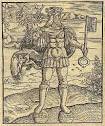
dmiventana.blogspot.com
Jano con llave y racimos de
364 × 437 - 66k - jpg |

moonmentum.com
No en vano es llamado Jano,
525 × 354 - 146k - jpg |

elmundodegallasalva.es
Omega o Jano Bifronte que
400 × 130 - 16k - jpg |
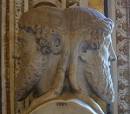
theaglaworld.com
Jano (cuya traducción al latin
500 × 439 - 165k - jpg |

janojoyas.com
Anillo atlante Layout Jano
1265 × 1499 - 328k - jpg |

dmiventana.blogspot.com
del dios Jano romano cuya
600 × 377 - 46k - jpg |
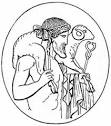
testimonios-de-un-disc...
HERMES
380 × 430 - 22k - jpg |

dmiventana.blogspot.com
del dios Jano romano cuya
570 × 685 - 133k - jpg |

dmiventana.blogspot.com
del dios Jano romano cuya
500 × 485 - 78k - jpg |
|
|
|
|
Réponse |
Message 42 de 79 de ce thème |
|
Haz hecho público que te gusta. Deshacer
|
|
|
|
  
 por Admin el Mar Jun 22, 2010 10:17 am por Admin el Mar Jun 22, 2010 10:17 am
A LA G:. D:. G:. A:. D:. U:.
Libertad * Igualdad * Fraternidad
S:.F:.U:.
EL SOLSTICIO DE VERANO, S. JUAN, JANUA, JANO
A todos los Hermanos, a cada uno según su grado y condición.:
Solsticio, derivado del latín solstitium, sol (el astro) y stitum (detención). La detención del sol que marca el tiempo en que este se halla más lejos del Ecuador y en que parece quedarse varado en los mares del universo unos días. El solsticio de verano se produce entre los días 21 y 22 de junio en el Hemisferio Norte cuando la distancia angular del Sol al Ecuador celeste es máxima. .Con el, el misterio de los cielos, la magnitud de los espacios cósmicos que nunca dejan de ser fuente de curiosidad para los hombres, toma cuerno en un día que no es como los demás. Un día donde la naturaleza, el hombre y las estrellas se disponen a celebrar una fiesta cargada de gran poder y magia. Es momento de fecundidad, de cosechas, de gracias por los dones recibidos y de acopios para pasar el otoño y el invierno.
También sabemos que en la tradición hindú, la fase ascendente se pone en relación con el deva-yna, y la fase descendente con el pitr- yna; por consiguiente, en el Zodíaco el signo de Cáncer, correspondiente al solsticio de verano, es la “puerta de los hombres”, que da acceso alpitr- yna, y el signo de Capricornio, correspondiente al solsticio de invierno, es la “puerta de los dioses “, que da acceso al deva-yána.
Los antecedentes en la celebración solsticial cabria hallarlos entre otros, en la celebración celta del Beltaine, o del bello fuego, o también fuego de Bel, ceremonia realizada en honor del Dios Belenos. Era el momento propicio en que los druidas purificaban el ganado y hacían plegarias por un año fructífero.
Los griegos dedicaban esta festividad al Dios Apolo y los romanos a la Diosa de la guerra Minerva y en todos los casos el fuego y las hogueras eran la herramienta central y simbólica.
Al otro lado del Mar Ártabro los festivales primordiales incaicos estaban en relación a los solsticios siendo majestuosa la celebración del Inti-Raymo o fiesta del Sol que el 24 de junio tenia lugar en la impresionante explanada de Sacsahuman en las cercanías del Cuzco imperial, recinto inaccesible y enigmático.
El cristianismo en su esfuerzo por hacer suyas las numerosas fuerzas que tienen su manifestación en esta fecha solar mágica optó por dedicarla a San Juan. San Juan Bautista es el autentico príncipe del santoral cristiano. Es el único santo del que se celebra su nacimiento y no la muerte.
Así nos lo advierte S. Agustín, afirmando que fue santificado en el vientre de su madre y vino al mundo sin culpa. Hijo de ancianos acerdote, Zacarías, casado con una mujer tan santa como estéril al nacer curó a su padre de una mudez que se había abatido como castigo por su poca diligencia en acreditar el anuncio del Ángel Gabriel cuando le avisó del estado de gravidez de su esposa. Al menos así es como nos lo narra Lucas en su Evangelio.
Juan es nacido el portavoz de la Redención. Por ello su festividad el 24 de junio es y se la asimila a una fiesta solar. De luz y de fuego. San Juan necesariamente encarna sobre si la liturgia del solsticio de verano porque para los cristicos era que hacer imposible erradicar de la práctica tradicional los más antiguos ritos de la Humanidad escenificados en la mas grande de todas las fiestas, las ancestrales celebraciones solares.
Concurren en favor de Juan su perfil juvenil y el atractivo ambiguo del personaje. Un hermoso ejemplar andrógino bellamente representado por Leonardo da Vinci en el siglo XVI.. En el estamos ante un Sol menor que abre camino al Sol mayor, Cristo. También nuevamente ante la dualidad, en ambos personajes se contraponen la muerte y la resurrección.
Juan con rebelde gallardía juvenil se muestra firme en su misión ante el rey Herodes preparando el camino de su Señor. Es una voz que dama en el desierto y que no calla. No calla ante la opresión y no gira el rostro ante los abusos de poder aunque no le afectasen personalmente.
Con desobediencia lozana, casi con inconsciencia púber, tanto insiste que, como suele suceder con los díscolos legitimados por la razón, su cabeza terminará sobre una bandeja de plata, en este caso como ofrenda obscena a una sensual y libidinosa bailarina, Salomé. Al menos es lo que nos refiere Flavio Josefo. A partir de ahí, ya mártir, el nombre de Juan se utiliza por el mundo cristiano impuesto con la fuerza positiva del mismo sol, con la viveza del fuego y la fecundidad de una virtud invencible.
En la Edad Media el ya entonces San Juan de los cristianos fue adoptado como Santo Patrón de los Collegia Fabrorum de artesanos y luego de los constructores, masones operativos desde donde paso su patronazgo a la masonería especulativa desde su mismo surgimiento a principios del Siglo XVIII.
Hay una corriente de estudiosos de la Masonería que asocia la fiesta solsticial masónica con San Juan el Limosnero, Gran Maestro de los Caballeros de San Juan de Jerusalén, Orden creada en el siglo XIII.
Juan el Limosnero, el patrón mas amado y venerado de los Templarios era patriarca de Antioquía . Juan de Antioquia, no duda en tiempos de fervor y cruzadas, en abandonar su posición de privilegio para dirigirse en el 550 a Jerusalén. Allí, en las andas y arenosas tierras bíblicas, se prodigó en socorrer a los peregrinos, creo una fraternidad para curar a los cristianos enfermos y heridos, ayudó económicamente a los que viajaban a Tierra Santa y combatían a los moros, o a los visitaban el Santo Sepulcro. La Iglesia Católica lo canonizó bajo el nombre de Juan el Limosnero o Juan de Jerusalén. De alguna forma se le considera el precursor de la Cruz Roja Internacional. También se afirma que el puesto de Hermano Hospitalario, que es regular en los cuadros logiales de nuestra Orden tanto en sus símbolos como en sus funciones son reminiscencias de este personaje.
Para los griegos los solsticios eran sinónimo de puertas siendo el solsticio de verano la puerta de los hombres. Etimológicamente la palabra Juan se relaciona con el vocablo latino Janua cuya traducción es puerta y del que se deriva januarius, enero, o iniciación. Sin salir de este contexto cabe subrayar que el significado de puerta lo tiene también la letra griega Delta que tiene forma de triangulo y que la era la que utilizaban los antiguos en las puertas de acceso a los templos iniciáticos.. Los cristianos sustituyeron el Janua o Janus etrusco y su equivalente Saturno de los frigios y los griegos con San Juan, nombre que en una de sus acepciones se interpreta como la gracia o el don de Dios. Dentro de la amplia onomástica cristiana de juanes es el Bautista el que representa al solsticio de verano.
Jano como personaje mitológico asoma inicialmente en la mitología hindú primitiva. Como dios de la naturaleza era guía de las almas y como a Osiris se le llama Sol teniendo bajo su custodia las puertas de Oriente y Occidente. Janus para los romanos era el dios que presidía el ingreso del Sol en los hemisferios celestes. El Dios de la iniciación a los misterios y al mismo tiempo el dios de las corporaciones de artesanos. Carácter a la vez iniciático y operativo.
Desde siempre la Francmasonería ha asimilado a Janus dentro de su estructura simbólica y derivado de elloe stá la importancia que el pueblo masónico concede a las fiestas solsticiales.
En el caso de la del verano, dedicada al Reconocimiento. Diversos autores masónicos hacen referencia a que la utilización del termino Logia de San Juan se remonta al tiempo de las cruzadas cuando los caballeros masones se unieron a sus similares de la Orden de San Juan de Jerusalén más conocidos como templarios y que e ngesto de solidaridad a los principios de estos aceptaron como propio a su patrón. Por sincronía todas las Logias de las corporaciones de constructores pasaron a llamarse Logias de San Juan.
Comúnmente se asume como patronos de la masonería universal conocida como simbólica o azul a Juan Bautista y a Juan Evangelista en los que se representa las dos fiestas solsticiales emanadas de la antigüedad, el primero de la del verano y de la del invierno, el segundo.
La tradición masónica las ha hecho celebraciones obligatorias y se auspicia como reconocimiento de su impronta ceremonial, el momento adecuado para llevar a cabo Asamblea General en Grandes Logias y Tenida Magna y Solemne en Logias regulares. Asimismo es preceptivo en el solsticio de verano la elección de Grandes Maestros, Venerables y Dignatarios.
Jano, dios bifronte, arcano, esotérico y enigmático. Fija una de sus caras en la tradición del pasado y la otro indica el rumbo hacia el devenir. Es una exhortación permanente a quien lo observa y lo comprende a asumir con dignidad y valor su tarea presente, aprovechando la experiencia de lo acaecido para anticiparse al destino. Es quizás esa cualidad visionaria encerrada en la alegoría de Jano el origen y resumen temporal y espacial de la Masonería desde una perspectiva iniciática.
De ella se nutre la Orden en lo profundo de su ser, en su esencia real y es a la vez el arma más poderosa conque se dota para garantizar su teleología inmanente.
El sol es por si solo un símbolo masónico de suma importancia. La Logia en esencia es una simbolización del Universo con un territorio enmarcado por piso terrenal y su techo celestial. El Venerable Maestro ilumina simbólicamente el Taller con su sabiduría cual el Sol que comienza su esplendor desde el Oriente. El Primer Vigilante simboliza al Sol en el ocaso al Occidente y el Segundo Vigilante simboliza el sol al Mediodía en la escala del tránsito. El medio natural de acción de un masón es la naturaleza y los fenómenos naturales son obligada fuente de estudio e inspiración. ¿Por ello, como ser ajenos al fenómeno del recorrido elíptico del Astro rey e ignorar la coincidencia de que sus puntos mas lejanos y distantes del Ecuador marcan cambios naturales de dos estaciones opuestas, verano e invierno?.
Jano nuevamente, la dualidad, símbolos también de la contradicción, lo bipolar representados estos conceptos opuestos en el piso cuadriculado delTaller, de la Logia, el blanco y el negro.
Preveer y preparar el porvenir, basando el trabajo presente en la experiencia y el conocimiento del pasado ha sido siempre la privilegiada tarea de la francmasonería. Una tarea empeñada en el cumplimiento de unos deberes y obligaciones que por su propia naturaleza no tienen principio ni fin, renovándose siempre en una noche mágica de solsticio de verano la apertura de esas puertaS invisibles del otro lado del espejo que nos instruyen al conocimiento del futuro y a las dimensiones prodigiosas de la realidad.
Queridos hermanos que el transito solsticial ilumine vuestros corazones con la llama de la pureza y el amor y alumbre en vuestras mentes la razón y la verdad en vuestras vidas.
Adaro
EN REALIDAD ACTUALMENTE LOS TROPICOS ESTAN EN GEMINIS-SAGITARIO (ERA DE PISCIS)
|
|
|
|
|
|
Réponse |
Message 43 de 79 de ce thème |
|
Lo que observamos del calendario es que hay un antagonismo entre el 1/5 y el 11/11, diseñado en funcion a la posicion de la Via Lactea. El primero del quinto mes tambien es 11:11 pero en el contexto a CANCER/69 adonde la suma del numero 6 y del numero 9 en binario me da 15 en binario que tambien es 11/11. Lo que observamos es que el 11/11 es el dia numero 306=2*153 del calendario hebreo que si le restamos a dicho numero la cifra de 119 (1/5 es el dia numero 119) llegamos a la cifra 306-119=187 adonde esta ultima esta relacionada con el dia de la expiacion que es el dia numero 187 del calendario. ¿ESE ES EL SECRETO DE LA INTERRELACION DE CAPRICORNIO CON EL CHIVO EXPIATORIO? |
|
|
|
Réponse |
Message 44 de 79 de ce thème |
|
JUPITER
PEDRO/PETER/ PITER (INGLES)
DIANA (NEXO CON JUPITER EN HECHOS 19)
DIANA/DOOR/PUERTA/JANO
Busqueda para JUPITER
1. Hechos 14:12: Y a Bernabé llamaban Júpiter, y a Pablo, Mercurio, porque éste era el que llevaba la palabra.
2. Hechos 14:13: Y el sacerdote de Júpiter, cuyo templo estaba frente a la ciudad, trajo toros y guirnaldas delante de las puertas, y juntamente con la muchedumbre quería ofrecer sacrificios.
3. Hechos 19:35: Entonces el escribano, cuando había apaciguado a la multitud, dijo: Varones efesios, ¿y quién es el hombre que no sabe que la ciudad de los efesios es guardiana del templo de la gran diosa Diana, y de la imagen venida de Júpiter?
|
|
|
|
Réponse |
Message 45 de 79 de ce thème |
|
LEONARDO DAVINCI
LEON (LEON de la tribu de JUDA)
NARDO=UNGIMIENTO DE BETANIA
Busqueda para NARDO
 ¿PORQUE MARIA MAGDALENA UNGE LOS PIES DE JESUS EN
EL NARDO TIENE UN FUERTE NEXO CON MARIA MAGDALENA EN CONTEXTO AL UNGIMIENTO DE BETANIA
Entonces María tomó una libra de perfume de NARDO puro, de mucho precio, y ungió los pies de Jesús, y los enjugó con sus cabellos; y la casa se llenó del olor del perfume.
DAVID
VID/VINO/GRIAL
VIDA
1232. Salmos 128:3: Tu mujer será como VID que lleva fruto a los lados de tu casa;
Tus hijos como plantas de olivo alrededor de tu mesa.
GENESIS 49
49:8 Judá, te alabarán tus hermanos; Tu mano en la cerviz de tus enemigos; Los hijos de tu padre se inclinarán a ti.
49:9 Cachorro de león, Judá; De la presa subiste, hijo mío. Se encorvó, se echó como león, Así como león viejo: ¿quién lo despertará?
49:10 No será quitado el cetro de Judá, Ni el legislador de entre sus pies, Hasta que venga Siloh; Y a él se congregarán los pueblos.
¿PORQUE MARIA MAGDALENA UNGE LOS PIES DE JESUS EN 49:11 Atando a la vid su pollino, Y a la cepa el hijo de su asna, Lavó en el vino su vestido, Y en la sangre de uvas su manto. 49:12 Sus ojos, rojos del vino, Y sus dientes blancos de la leche. (LAODICEA=ILUMINACION=APOCALIPSIS 3:14. LA ILUMINACION en la tora tiene un fuerte contexto con MARIA MAGDALENA Y EL SANTO GRIAL. En la pelicula "EL CODIGO DA VINCI" cuando ROBERT LANGDON Y SOPHIE NEVEU van a la mansion del INGLES SIR LEIGH TEABING es increible que PREVIO A QUE ESTE ULTIMO le revele a SOPHIE el nexo de MARIA MAGDALENA CON LEONARDO DA VINCI le hace cerrar los ojos y le pregunta de cuantas copas habia en la mesa en la SANTA CENA y justamente ella responde que una sola. TEABING, un ingles, cuando SOPHIE abre los ojos (ILUMINACION) le muestra que en dicha pintura no hay ninguna copa y que el GRIAL ES JUSTAMENTE LA MUJER QUE ESTA A LA DERECHA DEL SEÑOR CON PELO ROJIZO. LA ILUMINACION EN LA TORA ESTA 100% INTERRELACIONADA CON LA ESPOSA DE NUESTRO SEÑOR JESUCRISTO)

Sabemos que Cristo en el contexto a la santa cena tiene nexo con el planeta Jupiter.
Sedek en hebreo tiene connotacion con Jupiter. Concretamente Nuestro Señor en la Santa Cena tiene un fuerte nexo, insisto, con el planeta Marte y el planeta Jupiter. Sabemos que en Jupiter, la mancha roja, esta en la cercania del paralelo 19.47.
Further, volcanic activity is pronounced at 19.47° on other bodies in our solar system, including:
| The Sun |
Sunspot activity and the region
of peak temperatures is limited to 19.5° North and South. |
| Venus |
The presumably active major
volcano complexes Alpha and Beta Regio are near 19.5°. |
| Mars |
The vast Olympus Mons shield
cone volcano is at 19.5°. |
| Jupiter |
The red spot is at 19.5°. |
| Neptune |
In 1986 Voyager II discovered a
similar spot at 19.5°. |
Concretamente hay un nexo alquimico en el contexto al color rojo.
La cuadratura del circulo, osea la alquimia, tiene interrelacion con el numero 19.47. Noten la interrelacion de la SANTA CENA, en el contexto al Numero 13, en el contexto a la estrella de 6 puntas que simboliza a la UNION ENTRE EL HOMBRE CON LA MUJER.
El cubo de Metatrón

Cubo de Metatron (version incompleta que no contiene coordenadas válidas para el dodecaedro o el icosaedro). En la imagen se observan los trece círculos de la " Fruta de la vida"; a través del trazado de líneas se obtiene el Cubo de Metatrón, que sería únicamente el contenido del hexaedro central que surge en el dibujo.
Si observamos incluso la estrella de 13 puntas y completamos los vacios observaremos que necesitamos 6 circulso mas, osea 19 en total. Un numero muy interrelacionado con la Sabiduria/Sophia. ¿Porque la relacion de la mancha roja de Jupiter con el paralelo 19.57? Es obvio el nexo cientifico con la Santa Cena, en el contexto a la alquimia, osea la cuadratura del circulo. Marte, el planeta rojo, incluso tambien tiene volcanes en el mismo paralelo.
Vulcano era hijo de Jupiter/Zeus y Juno (de donde deriva Junio) y hermano de Marte. El dia de Vulcano, era el 23 de Agosto, justo al finalizar Leo y comienzo de Virgo (Esfinge de Gize). Sabemos que en el contexto al calendario gregoriano dicho dia es el dia numero 235 (23.5 es la inclinacion del eje de la tierra e incluso la distancia entre los tropicos y el ecuador. Entre tropico de Cancer y tropico de Capricornio tenemos 47 grados, dandole un nexo sabatico en el contexto al cuarto mandamiento con referencia al septimo dia segun Exodo 20 y Deuteronomio 5. La esfinge de Gize tiene fuerte relacion con los tropicos y los solsticios ya que esta diseñada en funcion a los mismos. Vemos incluso la interrelacion matematica con el ciclo de la luna de los 19 años en el contexto a los 235 ciclos lunares en 19 años solares. Es impresionante toda esta interrelacion cientifica con la SANTA CENA Y EL CODIGO DA VINCI.
JUPITER
PEDRO/PETER/ PITER (INGLES)
DIANA (NEXO CON JUPITER EN HECHOS 19)
DIANA/DOOR/PUERTA/JANO
NUMERO 19/DAN/OPHIUCO/ JUSTICIA/ $$$ / SCORPION / SOPHIA/ SABIDURIA / NUMERO DE ORO PHI/ PUERTA DE ORO
|
|
|
|
Réponse |
Message 46 de 79 de ce thème |
|
|
|
|
Réponse |
Message 47 de 79 de ce thème |
|
|
|
|
Réponse |
Message 48 de 79 de ce thème |
|
|
Janus

In ancient Roman religion and mythology, Janus is the god of beginnings and transitions, thence also of gates, doors, doorways, endings and time. He is usually a two-faced god since he looks to the future and the past. The Romans dedicated the month of January to Janus. His most apparent remnant in modern culture is his namesake, the month of January.
Though he was usually depicted with two faces looking in opposite directions (Janus Geminus (twin Janus) or Bifrons), in some places he was Janus Quadrifrons (the four-faced). The Romans associated Janus with the Etruscan deity Ani.
Janus was frequently used to symbolize change and transitions such as the progression of past to future, of one condition to another, of one vision to another, and of one universe to another. Hence, Janus was worshipped at the beginnings of the harvest and planting times, as well as marriages, births and other beginnings. He was representative of the middle ground between barbarity and civilization, rural country and urban cities, and youth and adulthood.
Theology and Functions
While the fundamental nature of Janus is debated, in most modern scholars' view the set of the god's functions may be seen as being organized around a simple principle: that of presiding over all beginnings and transitions, whether abstract or concrete, sacred or profane. Interpretations concerning the god's fundamental nature either limit it to this general function or emphasize a concrete or particular aspect of it (identifying him with light the sun, the moon, time, movement, the year, doorways, bridges etc.) or see in the god a sort of cosmological principle, i. e. interpret him as a uranic deity.
Almost all these modern interpretations were originally formulated by the ancients.
The function of 'god of beginnings' has been clearly expressed in numerous ancient sources, among them most notably perhaps Cicero, Ovid and Varro. As a god of motion he looks after passages, causes actions to start and presides over all beginnings, and since movement and change are bivalent, he has a double nature, symbolized in his two headed image.
He has under his tutelage the stepping in and out of the door of homes, the ianua, which took its name from him, and not viceversa. Similarly his tutelage extends to the covered passages named iani and foremost to the gates of the city, including the cultic gate called the Argiletum, named Ianus Geminus or Porta Ianualis from which he protects Rome against the Sabines. He is also present at the Sororium Tigillum, where he guards the terminus of the ways into Rome from Latium. He has an altar, later a temple near the Porta Carmentalis, where the road leading to Veii ended, as well as being present on the Janiculum, a gateway from Rome out to Etruria.
The connexion of the notions of beginning (principium), movement, transition (eundo), and thence time has been clearly expressed by Cicero. In general, Janus is at the origin of time as the guardian of the gates of Heaven: Jupiter himself moves forth and back because of Janus's working.
In one of his temples, probably that of Forum Holitorium, the hands of his statue were positioned to signify the number 355 (the number of days in a year), later 365, symbolically expressing his mastership over time. He presides over the concrete and abstract beginnings of the world, such as religion and the gods themselves, he too holds the access to Heaven and other gods: this is the reason why men must invoke him first, regardless of the god they want to pray or placate. He is the initiator of human life, of new historical ages, and financial enterprises: according to myth he was the first to mint coins and the as, first coin of the libral series, bears his effigy on one face.
Janus frequently symbolized change and transitions such as the progress of future to past, from one condition to another, from one vision to another, and young people's growth to adulthood. He was represented time, because he could see into the past with one face and into the future with the other. Hence, Janus was worshipped at the beginnings of the harvest and planting times, as well as at marriages, deaths and other beginnings. He represented the middle ground between barbarism and civilization, rural and urban, youth and adulthood. Having jurisdiction over beginnings Janus had an intrinsic association with omens and auspices.
Leonhard Schmitz suggests that he was likely the most important god in the Roman archaic pantheon. He was often invoked together with Iuppiter (Jupiter).
According to Macrobius citing Nigidius Figulus and Cicero, Janus and Jana (Diana) are a pair of divinities, worshipped as Apollo or the sun and moon, whence Janus received sacrifices before all the others, because through him is apparent the way of access to the desired deity.
A similar solar interpretation has been offered by A. Audin who interprets the god as the issue of a long process of development, starting with the Sumeric cultures, from the two solar pillars located on the eastern side of temples, each of them marking the direction of the rising sun at the dates of the two solstices: the southeastern corresponding to the Winter and the northeastern to the Summer solstice.
These two pillars would be at the origin of the theology of the divine twins, one of whom is mortal (related to the NE pillar, as confining with the region where the sun does not shine) and the other is immortal (related to the SE pillar and the region where the sun always shines). Later these iconographic models evolved in the Middle East and Egypt into a single column representing two torsos and finally a single body with two heads looking at opposite directions.
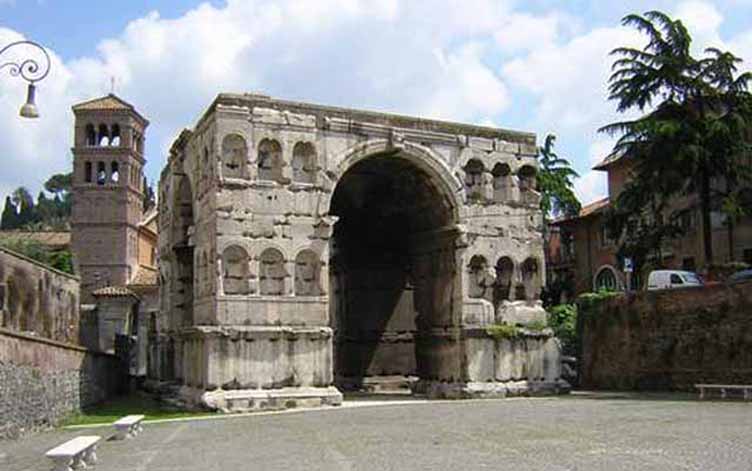
Arch of Janus in the Forum Boarium, framing the Church of St. George, Velabro
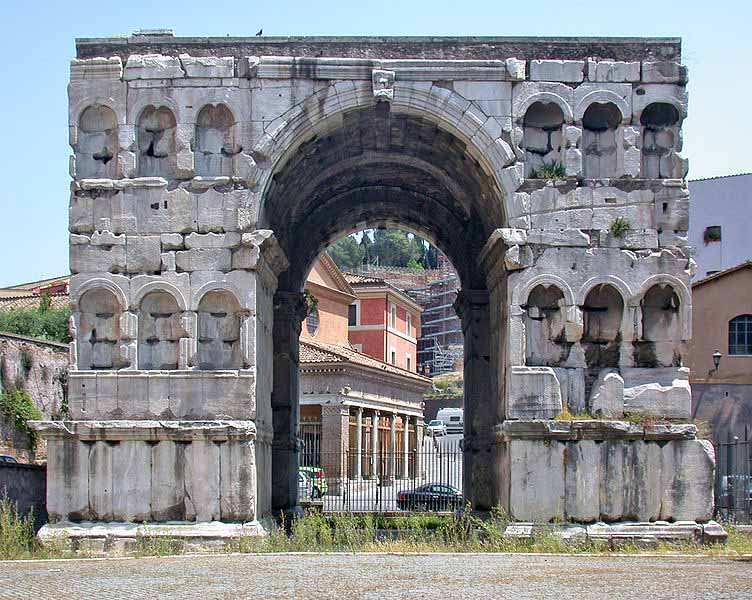
Temples
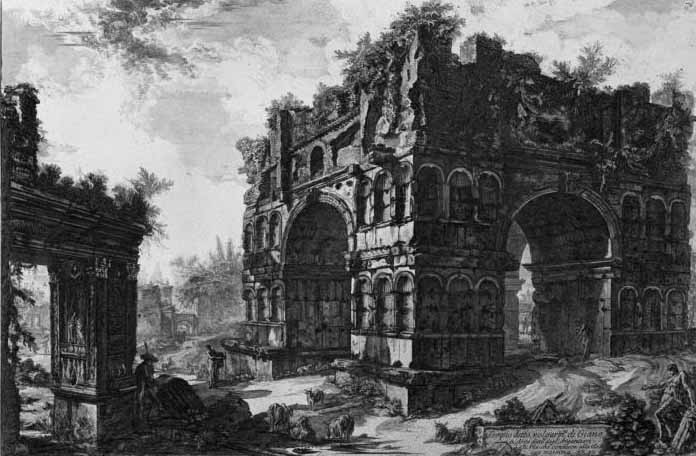
Numa built the Ianus geminus (also Janus Bifrons, Janus Quirinus or Portae Belli), a passage ritually opened at times of war, and shut again when Roman arms rested. It formed a walled enclosure with gates at each end, situated between the old Roman Forum and that of Julius Caesar, which had been consecrated by Numa Pompilius himself. About the exact location and aspect of the temple there has been much debate among scholars.
In wartime the gates of the Janus were opened, and in its interior sacrifices and vaticinia were held, to forecast the outcome of military deeds. The doors were closed only during peacetime, an extremely rare event. The function of the Ianus Geminus was supposed to be a sort of good omen: in time of peace it was said to close the wars within or to keep peace inside; in times of war it was said to be open to allow the return of the people on duty.
A temple of Janus is said to have been consecrated by the consul Gaius Duilius in 260 BCE after the Battle of Mylae in the Forum Holitorium. It contained a statue of the god with the right hand showing the number 300 and the left the number 65, i. e. the length in days of the solar year, and twelve altars, one for each month.
The four-sided structure known as the Arch of Janus in the Forum Transitorium dates from the 1st century CE: according to common opinion it was built by the Emperor Domitian. However American scholars L. Ross Taylor and L. Adams Holland on the grounds of a passage of Statius maintain that it was an earlier structure (tradition has it the Ianus Quadrifrons was brought to Rome from Falerii) and that Domitian only surrounded it with his new forum. In fact the building of the Forum Transitorium was completed and inaugurated by Nerva in 96 CE.
Rites
The rites concerning Janus were numerous. Owing to the versatile and far reaching character of the basic function of the god, marking beginnings and transitions, his presence was ubiquitous and fragmented. Apart from the rites solemnizing the beginning of the new year and of every month, there were the special times of year which marked the beginning and the closing of the military season, in March and October respectively.
These included the rite of the arma movere on March 1 and that of the arma condere at the end of the month performed by the Salii, and the Tigillum Sororium on October 1. Janus Quirinus was closely associated with the anniversaries of the dedications of the temples of Mars on June 1 (a date that corresponded with the festival of Carna, a deity associated with Janus: see below) and of that of Quirinus on June 29 (which was the last day of the month in the pre-Julian calendar). These important rites are discussed in detail below.
Any rite or religious act whatever first required the invocation of Janus, with a corresponding invocation to Vesta at the end (Janus primus and Vesta extrema). Instances are to be found in the Carmen Saliare, the formula of the devotio, the lutration of the fields and the sacrifice of the porca praecidanea, the Acta of the Arval Brethren.
Although Janus had no flamen, he was closely associated with the rex sacrorum who performed his sacrifices and took part in most of his rites: the rex was the first in the ordo sacerdotum hierarchy of priests.The flamen of Portunus performed the ritual greasing of the spear of the god Quirinus on August 17, day of the Portunalia, on the same date that the temple of Janus in the Forum Holitorium had been consecrated (by consul Caius Duilius in 260 BC). Portunus seems to be a god closely related to Janus, if with a specifically restricted area of competence, in that he presides over doorways and harbours and shares with Janus his two symbols, the key and the stick.
Beginning of the Year
The Winter solstice was thought to occur on December 25. January 1 was new year day: the day was consecrated to Janus since it was the first of the new year and of the month (kalends) of Janus: the feria had an augural character as Romans believed the beginning of anything was an omen for the whole. Thus on that day it was customary to exchange cheerful words of good wishes.
For the same reason everybody devoted a short time to his usual business, exchanged dates, figs and honey as a token of well wishing and made gifts of coins called strenae. Cakes made of spelt (far) and salt were offered to the god and burnt on the altar. Ovid states that in most ancient times there were no animal sacrifices and gods were propitiated with offerings of spelt and pure salt. This libum was named ianual and it was probably correspondent to the summanal offered the day before the Summer solstice to god Summanus, which however was sweet being made with flour, honey and milk.
Shortly afterwards, on January 9, on the feria of the Agonium of January the rex sacrorum offered the sacrifice of a ram to Janus.
Space
Janus was also involved in spatial transitions, presiding over home doors, city gates and boundaries. Numerous toponyms of places located at the boundary between the territory of two communities, especially Etrurians and Latins or Umbrians, are named after the god. The most notable instance is the Ianiculum which marked the access to Etruria from Rome. Since borders often coincided with rivers and the border of Rome (and other Italics) with Etruria was the Tiber, it has been argued that its crossing had a religious connotation; it would have involved a set of rigorous apotropaic practices and a devotional attitude. Janus would have originally regulated particularly the crossing of this sacred river through the pons sublicius.
Janus was the protector of doors, gates and roadways in general, as is shown by his two symbols, the key and the staff. The key too was a sign that the traveller had come to a harbor or ford in peace in order to exchange his goods. The rite of the bride's oiling the posts of the door of her new home with wolf fat at her arrival, though not mentioning Janus explicitly, is a rite of passage related to the ianua.
Myths
In discussing myths about Janus one should be careful in distinguishing those who are ancient and originally Latin and others which were later attributed to him by Greek mythographers. In the Fasti Ovid relates only the myths that associate Janus to Saturn, whom he welcomed as a guest and with whom eventually shared his kingdom in reward of his teaching the art of agriculture, and to the nymph Crane Grane or Carna, whom Janus raped and made the goddess of hinges as Cardea, while in the Metamorphoses he records his fathering with Venilia the nymph Canens, loved by Picus.
The myth of Crane has been studied by M. Renard and G. Dumezil. The first scholar sees in it a sort of parallel with the theology underlying the rite of the Tigillum Sororium. Crane is a nymph of the sacred wood of Helernus, located at the issue of the Tiber, whose festival of February 1 corresponded with that of Juno Sospita: Crane might be seen as a minor imago of the goddess.
Her habit of deceiving her male pursuers by hiding in crags in the soil reveals her association not only with vegetation but also with rocks, caverns, and underpassages. Her nature looks to be also associated with vegetation and nurture: G. Dumezil has proved that Helernus was a god of vegetation, vegetative lushiousness and orchards, particularly associated with vetch. As Ovid writes in his Fasti, June 1 was the festival day of Carna, besides being the kalendary festival of the month of Juno and the festival of Juno Moneta. Ovid seems to purposefully conflate and identify Carna with Cardea in the aetiologic myth related above.
Consequently the association of both Janus and god Helernus with Carna-Crane is highlighted in this myth: it was customary on that day eating vetch and lard, which were supposed to strengthen the body. Cardea had also magic powers for protecting doorways (by touching thresholds and posts with wet hawthorn twigs) and newborn children by the aggression of the striges (in the myth the young Proca). M. Renard sees the association of Janus with Crane as reminiscent of widespread rites of lustration and fertility performed through the ritual walking under low crags or holes in the soil or natural hollows in trees, which in turn are reflected in the lustrative rite of the Tigillum Sororium.
Macrobius relates Janus was supposed to have shared a kingdom with Camese in Latium, on a place then named Camesene. He states that Hyginus recorded the tale on the authority of a Protarchus of Tralles. In Macrobius Camese is a male: after Camese's death Janus reigned alone. However Greek authors make of Camese Janus's sister and spouse: Atheneus citing a certain Drakon of Corcyra writes that Janus fathered with his sister Camese a son named Aithex and a daughter named Olistene. Servius Danielis states Tiber (i. e. Tiberinus) was their son.
Arnobius writes that Fontus was the son of Janus and Juturna. The name itself proves that this is a secondary form of Fons modelled on Janus, denouncing the late character of this myth: it was probably conceived because of the proximity of the festivals of Juturna (January 11) and the Agonium of Janus (January 9) as well as for the presence of an altar of Fons near the Janiculum and the closeness of the notions of spring and of beginning.
Plutarch writes that according to some Janus was a Greek from Perrhebia.
When Romulus and his men kidnapped the Sabine women, Janus caused a volcanic hot spring to erupt, resulting in the would-be attackers being buried alive in the deathly hot, brutal water and ash mixture of the rushing hot volcanic springs that killed, burned, or disfigured many of Tatius's men. This spring is called Lautolae by Varro.
Later on, however, the Sabines and Romans agreed on creating a new community together. In honor of this, the doors of a walled roofless structure called 'The Janus' (not a temple) were kept open during war after a symbolic contingent of soldiers had marched through it. The doors were closed in ceremony when peace was concluded.
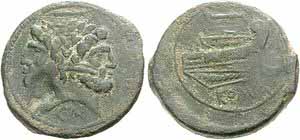
A bronze as from Canusium depicting a laureate
Janus with the prow of a ship on the reverse
Origin, Legends and History
In accord with his fundamental character of being the Beginner Janus was considered by Romans the first king of Latium, sometimes along with Camese. He would have received hospitably god Saturn, who, expelled from Heaven by Jupiter, arrived on a ship to the Janiculum. Janus would have also effected the miracle of turning the waters of the spring at the foot of the Viminal from cold to scorching hot in order to fend off the assault of the Sabines of king Titus Tatius, come to avenge the kidnapping of their daughters by the Romans.
His temple named Janus Geminus had to stand open in times of war. It was said to have been built by king Numa Pompilius, who kept it always shut during his reign as there were no wars. After him it was closed very few times, one after the end of the first Punic War, three times under Augustus and once by Nero. It is recorded that emperor Gordianus III opened the Janus Geminus.
It is a noteworthy curiosity that the opening of the Janus was perhaps the last act connected to the ancient religion in Rome: Procopius writes that in 536 CE, during the Gothic War, while general Belisarius was under siege in Rome, at night somebody opened the Janus Geminus stealthily, which had long stayed closed since 390, year on which Theodosius I's edict banned the ancient cults. Janus was faithful to his liminal role also in the marking of this last act.
The uniqueness of Janus in Latium has suggested to L. Adams Holland and J. GagŽ the hypothesis of a cult brought from far away by sailors and strictly linked to the amphibious life of the primitive communities living on the banks of the Tiber. In the myth of Janus the ship of Saturn as well as the myth of Carmenta and Evander are remininscent of an ancient Preroman sailing life. The elements that connect Janus to sailing are summarized here below as presented in the work of Gage.
1. The boat of Janus and the beliefs of the primitive sailing techniques.
a) The proximity of Janus and Portunus and the functions of the flamen Portunalis.
The temple of Janus was dedicated by C. Duilius on August 17, day of the Portunalia. The key was the symbol of both gods and was also meant to signify that the boarding boat was a peaceful merchant boat.
The flamen Portunalis oiled the arms of Quirinus with an ointment kept in a peculiar container named persillum, term perhaps derived from Etruscan persie. A similar object seems to be represented in a fresco picture of the Calendar of Ostia on which young boys prepare to apply a resin contained in a basin to a boat standing on a cart, i.e. yet to be launched.
b) The Tigillum Sororium would be related to a cult of wood of the Horatii, as shown by the episodes of the pons sublicius defended by Horatius Cocles and of the posts of the main entrance of the temple of Jupiter Capitolinus, on which Marcus Horatius Pulvillus lay his hand during the dedication rite. GagŽ thinks the magic power of the Tigillum Sororium should be due to the living and burgeoning nature of wood.
2. Falacer and flamen Falacer as related to a sacred tree useful in shipbuilding. This flamen would be related to Janus as the flamen Portunalis is because of the association of pater Falacer and shipping.
a) The name of divus pater Falacer[208] would be that of a Sabine god similar to Quirinus, i.e. a spear god from the town of Falacrinae.[209] The term is related to falarica, a javelin soaked in pitch, ending with a point of inflammable material. Falas in Etruscan means pole or tower. The name could be related to that of the faba graeca the Greek lotus, imported from Syria (Celtis australis). This tree would have been used among certain communities as the wild olive was to make rolls in order to haul ships upon. The name of the flamen would reflect an ancient name of this tree later corrupted into faba.
b) Religious quality of trees as the wild olive (analogous to that of corniolum and wild fig) to sailing communities: it does not rot in sea water, thence it was used in shipbuilding and the making of rolls for the hauling of ships overland.
3. Janus and the depiction of Boreas as Bifrons: climatological elements.
a) The calendar of Numa and the role of Janus. Contradictions of the ancient Roman calendar on the beginning of the new year: originally March was the first month and February the last one. January, the month of Janus, became the first afterwards and through several manipulations. The liminal character of Janus is though present in the association to the Saturnalia of December, reflecting the strict relationship between the two gods and the rather blurred distinction of their stories and symbols. The initial role of Janus in the political-religious operations of January: nuncupatio votorum spanning the year, imperial symbol of the boat in the rite of opening of the sailing season of the vota felicia. Janus and his myths allow for an ancient interpretation of the vota felicia different from the Isiadic one.
b) The idea of the Seasons in the ancient traditions of the Ionian Islands. The crossing of the Hyperborean myths. Cephalonia as a place at the cross of famous winds. Application of the theory of winds for the navigation in the Ionian Sea. The type Boreas Bifrons as probable model of the Roman Janus.
The observation has been made first by the Roscher Lexicon: "Ianus is he too, doubtlessly, a god of wind" and repeated in the RE Pauly-Wissowa s.v. Boreas by Rapp. P. Grimal has taken up this interpretation connecting it to a vase with red figures representing Boreas pursuing the nymph Oreithyia: Boreas is depicted as a two headed winged demon, the two faces with beards, one black and the other fair, perhaps symbolizing the double movement of the winds Boreas and Antiboreas. This proves the Greek of the V century BC did know the image of Janus. Gage feels compelled to mention here another parallel with Janus to be found in the figure of Argos with one hundred eyes and in his association with his murderer Hermes.
Among the winds studied by Greek sailors one can number Auster and Aquilon. Favonius on the other hand is not known to the Greek but is of particular relevance to the Roman as it started to blow exactly on the sixth day before the Idi of February: it was regarded as the bringer of the Springtime renewal of life. Few days later recurred the festival of Faunus, on the idi.
c) Solar, solsticial and cosmological elements. While there is no direct proof of an original solar meaning of Janus, this being the issue of learned speculations of the Roman erudits initiated into the mysteries and of emperors as Domitian, the derivation from a Syrian cosmogonic deity proposed by P. Grimal looks more acceptable. Gage though sees an ancient, preclassical Greek mythic substratum to which belong Deucalion and Pyrrha and the Hyperborean origins of the Delphic cult of Apollo as well as the Argonauts. The beliefs in the magic power of trees is reflected in the use of the olive wood, as for the rolls of the ship Argo: the myth of the Argonauts has links with Corcyra, remembered by Ampelius.
4. The sites of the cults of Janus at Rome and his associations in ancient Latium.
a) Argiletum. Varro gives either the myth of the killing of Argos as an etymology of the word Argi-letum (death of Argos), which is not reliable, or the place standing upon a soil of clay, argilla. However the names in -etum are usually referred to trees. The place so named stood at the foot of the Viminal, the hill of the reeds. It could also be referred to the white willow tree, used to make objects of trelliswork. The word could also be linked to the Argei the 27 or 30 dolls thrown into the Tiber in the rite of May 15. On them the more accepted opinion (at the time, 1979) is that they represented Greeks, Argei being their ancient designation by the Romans. The rite could be a substitution rite for human sacrifices or be original as such. The most supported opinion among the Ancient was that of a rite of substitution of human sacrifices to Saturn ascribed to Hercules. At any rate the rite must be associated to a local Preroman life linked to the Tiber, to a river religion in which the reeds harvested in the river itself or its banks had a peculiar value. Janus though is not present in this rite.
b) The Janiculum may have been inhabited by people who were not Latin but had close alliances with Rome.The right bank of the Tiber would constitute a typical, commodious landing place for boats and the cult of Janus would have been double as far as amphibious.
c) Janus's cultic alliances and relations in Latium show a Prelatin character. Janus has no association in cult (calendar or prayer formulae) with any other entity. Even though he has the epithet of Pater he is no head of a divine family; however some testimonies lend him a companion, sometimes female and a son and/or a daughter. They belong to the family of the nymphs or genies of springs. Janus intervenes in the miracle of the hot spring during the battle between Romulus and Tatius: Juturna and the nymphs of the springs are clearly related to Janus as well as Venus, that in the Ovid's Metamorphoses cooperates in the miracle and that may have been confused with Venilia, or perhaps the two were originally one. Janus has a direct link only to Venilia with whom he fathered Canens.
The magic role of the wild olive tree (oleaster) is prominent in the description of the duel between Aeneas and Turnus reflecting its religious significance and powers: it was sacred to sailors, also to those who had shipwrecked as a protecting guide to the shore. It was probably venerated by a Prelatin culture in association with Faunus. In the story of Venulus coming back from Apulia too we see the religious connotation of the wild olive: the king discovers one into which a local shepherd had been had been turned for failing to respect some nymphs he had come across in a nearby cavern, apparently Venilia, as she was the deity associated with the magic virtues of such tree. GagŽ finds it remarkable that the characters related to Janus are in the Aeneis on the side of the Rutuli. In the Aeneis Janus would be represented by Tiberinus. Olistene, the daughter of Janus with Camese, may reflect in her name that of the olive or oleaster, or of Oreithyia.Camese may be reflected in Carmenta: Evander's mother is from Arcadia, comes to Latium as an exile migrant and has her two festivals in January: Camese's name does not look Latin.
5. Sociological remarks
a) The vagueness of Janus's association with the cults of primitive Latium and his indifference towards social composition of the Roman State suggest the inference that he was a god of an earlier amphibious merchant society in which the role of the guardian was indispensable.
b) Janus bifrons and the Penates. Even though the cult of Janus cannot be confused with that of the Penates, related with Dardanian migrants from Troy, the binary nature of the Penates and of Janus postulates a correspondent ethnic or social organisation. Here the model is thought to be provided by the cult of the Magni Dei or Cabeiri preserved at Samothrace and worshipped particularly among sailing merchants. The aetiological myth is noteworthy too: at the beginning one finds Dardanos and his brother Iasios appearing as auxiliary figures in a Phrygian cult to a Great Mother. In Italy there is a trace of a conflict between worshippers of the Argive Hera (Diomedes and the Diomedians of the south) and of the Penates. The cult of Janus looks to be related to social groups remained at the fringe of the Phrygian ones. They might or might not have been related to the cult of the Dioscuri.
c) The ianitrices in Roman law. The term is attested by Modestinus in the Digesta 38, 10, 4, 6 and glossed by Isidorus Origines 9, 7, 17. It denotes the spouses of the brothers of one's husband: it is attested only in the imperial period and in the juridical language. It has a symmetric correspondent in levir brother of one's husband. It is possible to suppose that the word ianitrix may at its origin have issued from the cult of Janus, which could have given special functions to women married to the two indivisible companions while later it got fixed to a special sense of relations. This topic bears on the matrimonial practices of early Roman society which show traces of a regimen different from the classic one, i. e. monogamic with exogamy.
Janus and Juno
The relationship between Janus and Juno is defined by the closeness of the notions of beginning and transition and the functions of conception and delivery, result of youth and vital force. The reader is referred to the above sections Cultual epithets and Tigillum Sororium of this article and the corresponding section of article Juno.
Janus and Quirinus
Quirinus is a god that incarnates the quirites, i.e. the Romans in their civil capacity of producers and fathers. He is surnamed Mars tranquillus peaceful Mars, Mars qui praeest paci Mars who presides on peace. His function of custos guardian is highlighted by the location of his temple inside the pomerium but not far from the gate of Porta Collina or Quirinalis, near the shrines of Sancus and Salus. As a protector of peace he is nevertheless armed, in the same way as the quirites are, as they are potentially milites soldiers: his staue represents him is holding a spear. For this reason Janus, god of gates, is concerned with his function of protector of the civil community. For the same reason the flamen Portunalis oiled the arms of Quirinus, implying that they were to be kept in good order and ready even though they were not to be used immediately. Dumezil and Schilling remark that as a god of the third function Quirinus is peaceful and represents the ideal of the pax romana i. e. a peace resting on victory.
Janus and Portunus
Portunus may be defined as a sort of duplication inside the scope of the powers and attributes of Janus. His original definition shows he was the god of gates and doors and of harbours. In fact it is debated whether his original function was only that of god of gates and the function of god of harbours was a later addition: Paul the Deacon writes: "... he is depicted holding a key in his hand and was thought to be the god of gates". Varro would have stated that he was the god of harbours and patron of gates. His festival day named Portunalia fell on August 17, and he was venerated on that day in a temple ad pontem Aemilium and ad pontem Sublicium that had been dedicated on that date.[229] Portunus, unlike Janus, had his own flamen, named Portunalis. It is noteworthy that the temple of Janus in the Forum Holitorium had been consecrated on the day of the Portunalia and that the flamen Portunalis was in charge of oiling the arms of the statue of Quirinus.
Janus and Vesta
The relationship between Janus and Vesta touches on the question of the nature and function of the gods of beginning and ending in Indo-European religion. While Janus has the first place Vesta has the last, both in theology and in ritual (Ianus primus, Vesta extrema). The last place implies a direct connexion with the situation of the worshipper, in space and in time. Vesta is thence the goddess of the hearth of homes as well as of the city. Her inextinguishable fire is a means for men (as individuals and as a community) to keep in touch with the realm of gods. Thus there is a reciprocal link between the god of beginnings and unending motion, who bestows life to the beings of this world (Cerus Manus) as well as presiding over its end, and the goddess of the hearth of man, which symbolises through fire the presence of life. Vesta is a virgin goddess but at the same time she is considered the mother of Rome: she is thought to be indispensable to the existence and survival of the community.
Association with non-Roman gods
The god with two faces appeared repeatedly in Babylonian art. Reproductions of the image of such a god, named Usmu, on cylinders in Sumero-Accadic art. On plate XXI, c, Usmu is seen while introducing worshippers to a seated god. Janus-like heads of gods related to Hermes have been found in Greece, perhaps suggesting a compound god.
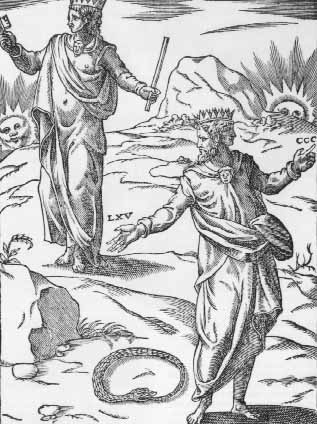
Janus and the Ouroboros
ROMAN GODS and GODDESSES
ROMAN MYTHOLOGY
ROME INDEX
GREEK GODS
GREEK MYTHOLOGY
GREECE INDEX
ShareThis
ANCIENT AND LOST CIVILIZATIONS
ALPHABETICAL INDEX OF ALL FILES
CRYSTALINKS HOME PAGE
PSYCHIC READING WITH ELLIE
2012 THE ALCHEMY OF TIME
|
|
|
|
Réponse |
Message 49 de 79 de ce thème |
|
|
|
 Premier Premier
 Précédent
35 a 49 de 79
Suivant Précédent
35 a 49 de 79
Suivant Dernier
Dernier
|

